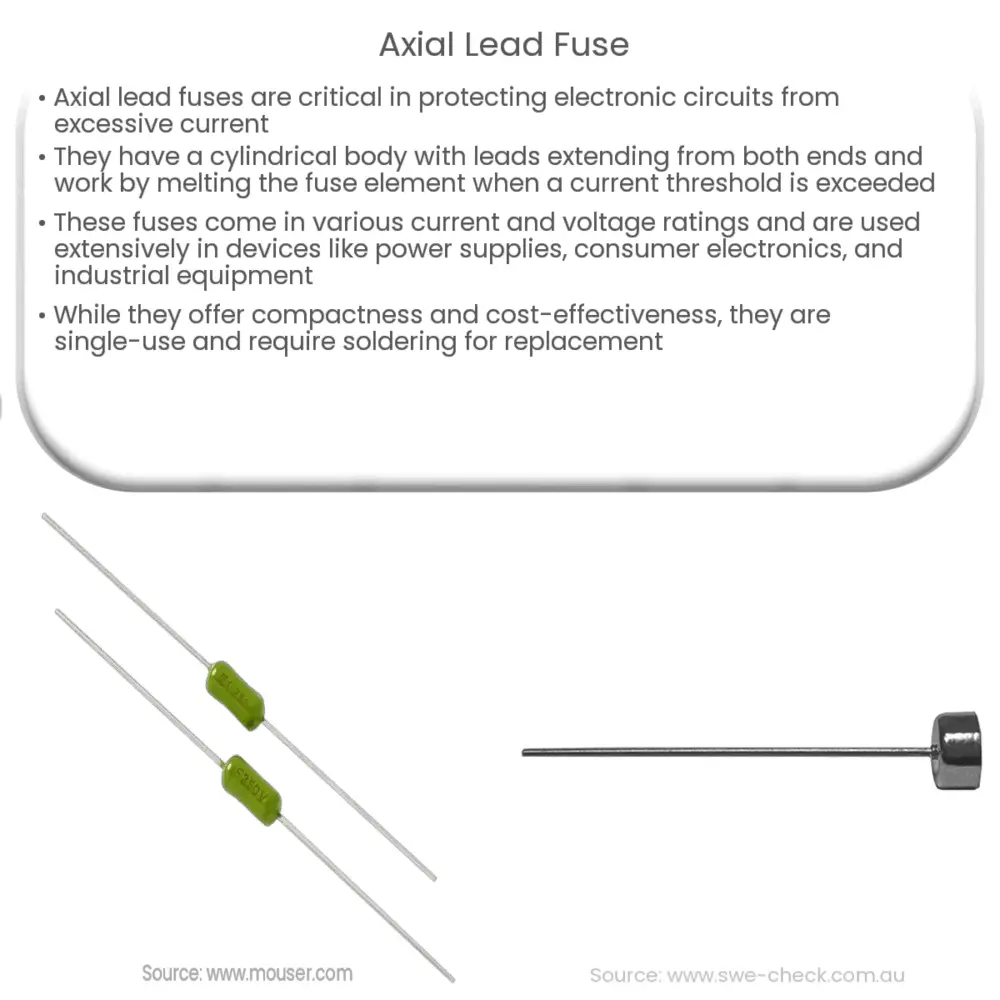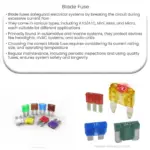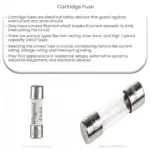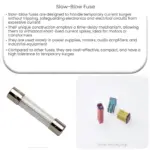Axial lead fuses are compact, sacrificial devices that protect electronic circuits by interrupting excessive current flow.

Axial Lead Fuse: An Essential Component for Circuit Protection
Introduction
Axial lead fuses are widely used as essential components in the field of electronics for their role in safeguarding electronic circuits. They act as sacrificial devices that prevent damage to circuits by interrupting the flow of excessive current. This article explores the axial lead fuse, its working principle, and its applications in various electronic devices and systems.
What is an Axial Lead Fuse?
An axial lead fuse is a type of fuse with leads extending axially from both ends of the cylindrical fuse body. The fuse body typically consists of a metal fuse element enclosed within a ceramic, glass, or epoxy housing. The fuse element is designed to melt and break the electrical connection when the current flowing through it exceeds a specific threshold, thus protecting the circuit from damage.
Working Principle
The basic working principle of an axial lead fuse is simple: when the current in the circuit exceeds the fuse’s rated current, the fuse element heats up and melts. As the fuse element melts, it creates a gap in the electrical connection, effectively stopping the flow of excessive current and preventing further damage to the circuit. Once the fuse has blown, it must be replaced to restore the electrical connection.
Construction and Materials
The construction of an axial lead fuse starts with the fuse element, which is typically made of a metal alloy, such as tin-lead, silver, or copper. This element is selected based on its melting point and its ability to carry the desired current without melting. The fuse element is then enclosed in a protective housing made from glass, ceramic, or epoxy materials. This housing serves to insulate the fuse element from its surroundings and provides mechanical strength to the overall structure.
The leads of the axial lead fuse are made of a conductive material, often tin-plated copper, and extend from both ends of the fuse body. These leads are designed to be soldered directly to a printed circuit board (PCB) or connected to other electronic components, allowing for easy integration into various electronic systems.
Types and Ratings
Axial lead fuses are available in a wide range of current ratings, voltage ratings, and physical sizes. The current rating, expressed in amperes (A), determines the maximum current the fuse can carry without blowing. The voltage rating, expressed in volts (V), indicates the maximum voltage the fuse can withstand without breaking down. Axial lead fuses are commonly found in ratings ranging from a few milliamperes to several amperes and voltage ratings from a few volts to several hundred volts.
In addition to these basic ratings, axial lead fuses can also be classified according to their time-current characteristics or “blow” speed. These characteristics determine how quickly the fuse will blow in response to an overcurrent condition. Common types include fast-acting fuses, slow-blow fuses, and time-delay fuses.
Selection Criteria
Choosing the correct axial lead fuse for a specific application is crucial for ensuring proper circuit protection. Several factors must be considered when selecting a fuse, including the normal operating current, the maximum voltage, and the environmental conditions in which the fuse will operate. Additionally, the fuse’s time-current characteristics should match the requirements of the specific application. For instance, fast-acting fuses are suitable for sensitive electronic components, while slow-blow or time-delay fuses are better suited for inductive loads, such as motors or transformers, that may experience temporary current surges during normal operation.
Applications
Axial lead fuses find applications in a wide variety of electronic devices and systems, offering reliable protection against overcurrent conditions. Some common applications include:
- Power supplies: Protecting sensitive components from overcurrents caused by short circuits or component failures.
- Consumer electronics: Providing overcurrent protection in devices such as televisions, computers, and audio equipment.
- Industrial equipment: Safeguarding motors, transformers, and other inductive loads from damage due to excessive currents.
- Automotive electronics: Protecting vehicle systems, such as engine control units and infotainment systems, from electrical faults.
- Telecommunication devices: Preventing damage to communication equipment caused by overcurrents or power surges.
Advantages and Limitations
Axial lead fuses offer several advantages, making them a popular choice for circuit protection:
- Compact size: Their small form factor allows for easy integration into space-constrained electronic devices.
- Cost-effective: Axial lead fuses are generally inexpensive, providing a cost-effective solution for overcurrent protection.
- Reliable performance: They provide consistent and predictable performance, ensuring reliable circuit protection.
- Wide range of ratings: The availability of various current and voltage ratings, as well as time-current characteristics, allows for flexibility in selecting the appropriate fuse for a specific application.
However, axial lead fuses also have some limitations:
- One-time use: Once a fuse has blown, it must be replaced, which can be inconvenient and time-consuming in some situations.
- Soldering requirements: The need for soldering the leads to a PCB or other components can be a drawback in applications where quick replacement is necessary.
Conclusion
Axial lead fuses are an essential component for safeguarding electronic circuits from damage due to overcurrent conditions. With their compact size, cost-effective nature, and reliable performance, they are widely used in a variety of applications, from consumer electronics to industrial equipment. By understanding the working principle, types, ratings, and selection criteria of axial lead fuses, engineers and technicians can effectively choose and implement the appropriate fuse for their specific needs, ensuring the reliable operation and longevity of their electronic devices and systems.




